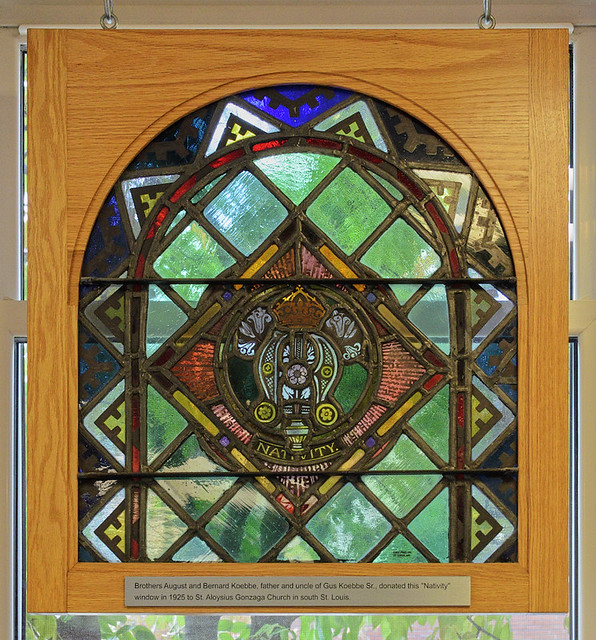SOÛLARD, in French, means ‘drunkard’, and this name seems rather appropriate for the Soulard neighborhood of Saint Louis, Missouri, known for its numerous bars, as well as the riotous behavior of visitors during its annual Mardi Gras celebrations. But this near south-side neighborhood — largely delineated by Interstate 55 and South Broadway — has many charms.
This neighborhood gets its name from the colonial figure of Antoine Pierre Soulard (1766-1825). He was a Frenchman, who came to these shores fleeing the Revolution. He eventually became the King of Spain’s Surveyor General of Upper Louisiana — a vast land which included the Saint Louis area. After President Thomas Jefferson purchased the Louisiana territory — an act which doubled the size of the United States — it was Soulard who handed over this part of the territory to the American governor. After his retirement, Soulard tended to his orchard, which was located in this neighborhood which now bears his name.
Here are some photos I took this summer, in the Soulard neighborhood, during a walk around a couple of blocks, at sunset and dusk, near the historic
Soulard Farmers Market.
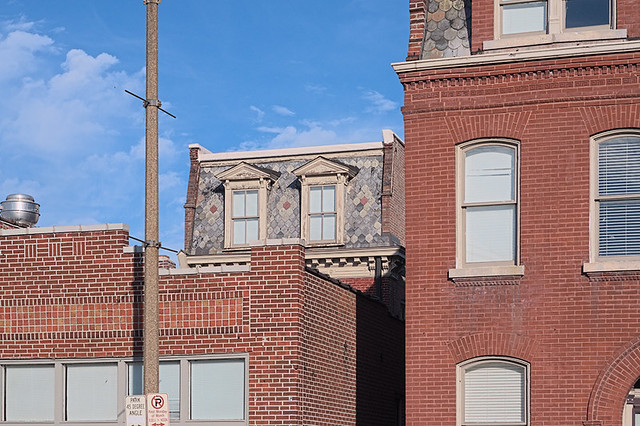
Much of the architecture of this area dates from the second half of the 19
th century through the first few decades of the 20
th. Due to benign neglect, this neighborhood maintained its charm while other areas nearby were destroyed by modernization. The fury of ‘urban renewal’ throughout the nation subsided in the early 1970s — often attributed to the failure of the huge Pruitt-Igoe housing complex in north Saint Louis — and the beauty of the once-hated Victorian-era architecture was rediscovered.
Other neighborhoods in the city — particularly on the north side — are slowly disappearing, due to neglect which cannot be called benign. Recent in-fill housing in these areas tend to be rather disappointing, being largely suburban-style homes with little charm, character, or solidity.

Notice the ornate detail on this building, exceeding the quality of work that is done today; but this level of artistry is commonplace here.
Many buildings here have Mansard-style roofs. These are named after
François Mansart, a royal architect of the Baroque period in France, who popularized this kind of steep roof, which allows for an additional occupiable story on buildings. The style experienced a revival, especially in Paris during the Second French Empire, and was widely copied in the English-speaking world, including here in Soulard. One of the disadvantages of the Mansard roof is that the top story is usually an undesirable place to live: hereabouts, it gets extremely hot under the roof during summer, while in Paris before the invention of elevators, the Mansard was a long climb up from street level, and so the Mansard, often the location of the lowest-rent apartments, became associated with starving artists and bohemians.
The 1960s saw another revival of the Mansard form, but the quality of the work tended to be bad — or cheap and tasteless — and it inspired the local blog
Bad Mansard.
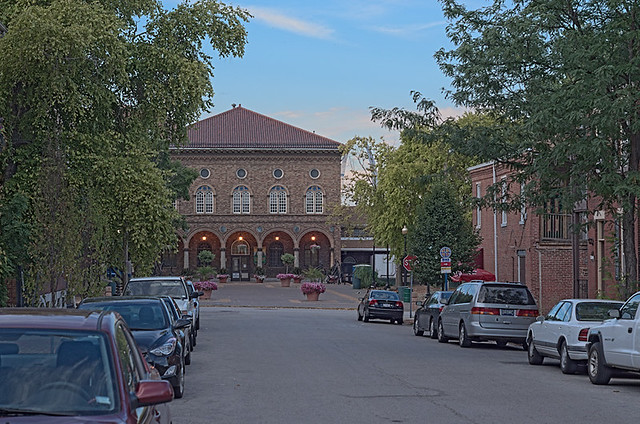
At the end of the street is the Soulard Farmers Market, which dates back to 1779. You can see the
Gateway Arch to the right of the 1929 building, which is modeled after Brunelleschi's
Ospedale deli Innocenti or Foundling's Hospital, in Florence.
The amenities of modern supermarkets are lacking here, likewise lacking is the middle-class who patronize those markets; rather, we find here mainly the poor and the wealthy. The form, organization, and economics of this market can be best called premodern, where the City leases out stalls here to farmers and merchants; similar arrangements can be found in the ancient cities in Europe and elsewhere.

In Soulard, it is the tops of buildings that tend to have most of the charm. I suspect that architectural details closer to the ground may have been destroyed or otherwise lost in the past century, and you still can see clues of shutters, balconies, and decoration that have been removed. Wood needs to be painted periodically otherwise it will rot, while much ironwork was scrapped during the Second World War to make steel for the war effort. Some buildings here have been fully restored, but most have not.
Home prices can be high here — note the expensive automobiles seen here — and decades ago, many of the old-time residents resented the intrusion of newcomers in the neighborhood who drove up rents and who had odd lifestyles.
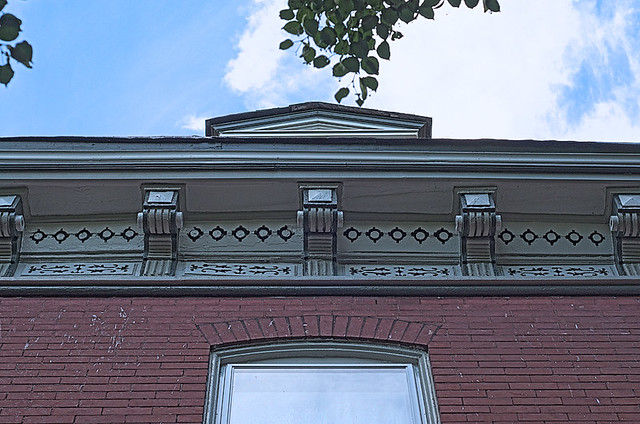
A major source of Soulard's popularity is undoubtably its beauty, despite its high crime rate, and its many restaurants make it a popular area for weekday lunch.
By means of comparison, the artist
David Clayton describes the value of Boston's Beacon Hill neighborhood:
This past weekend I drove down to Boston from southern New Hampshire to meet a friend who was visiting for the weekend. As we walked around town we wandered into the Beacon Hill area. This is the old heart of the town and full of elegant 18th-century terraced homes. They are built in a variation of the style that in England we would call Georgian. I’m not sure what it is called here, perhaps ‘colonial’ style? These are right at the top end of the price range for property in Boston.
Why are they so sought after? Well location will have a lot to do with it certainly. You would probably pay a fortune for the ugliest shoebox here if it could take a bed. But I would say also that their beauty is a big factor too. Beauty adds value because it stimulates greater demand and pushes the price tag up. And why are they beautiuful? Two hundred years of New England weather softening the edges on the red-brick or cobblestone forms probably adds something. But it is more than this. The main reason, I suggest, is their harmonious proportions.
The buildings in Soulard were built over the better part of a century, and yet the structures tend to harmonize with each other, despite being of varying style. Undoubtably part of this is due to the requirement that all buildings were to be built of brick — this law came into force after a steamboat explosion led to the destruction of a sizable part of downtown — but also because the buildings harmonize with each other proportionately. All of this predates Le Corbusier and the Bauhaus, the early champions of Modernism, who discarded centuries of aesthetic wisdom.

This is the former Saint Elizabeth Settlement House, which was originally a Catholic orphanage.
David Clayton
continues:
What struck me about these houses is how simple and reproducible their design is. They have a simple symmetrical arrangement of windows, one above the other, and a pointy roof. There is some decorative work around the doors and the windows, but it could never be called flamboyant. If I knew about building materials then I reckon I could design one myself. Yet despite their simplicity they look good and it is as a result of the traditional proportionality.
Given this simplicity and the value that beauty adds to buildings, I am surprised that it hasn’t occurred to more developers and architects to study traditional proportion and use it, if only for economic reasons.
Look at the photos in this article. Notice how in every case the window size varies, storey to storey, so that the first is to the second as the second is the third and so on. When this rhythmical progression corresponds to the traditional pattern then the result is elegance. Sometimes the order changed around slightly so that it is not always the largest at the bottom. The dimensions of the first and second might be changed so the biggest storey is always the main living area. These architects didn’t play tricks – they put things where you expected them to be, so that the outward signs give an indication of the internal purpose. Similarly, the main door is always more prominent than the servants’ entrance. (You can’t count on this now. I was at an art gallery recently, which was a modern building made completely of reflective glass and the doorway was indistinguishable from any other panel. There was no indication through the external design where the door was. In fact it was placed offset to one side in a counter-intuitive position, presumably deliberately. I had to wait until I saw someone coming out before I knew where I could get in!)
Coming back to Beacon Hill, I am convinced that these houses looked just about as good the day they were built and if anyone chose to conform to these basic patterns today, then it would look good and sell at a high price. This has to be the simplest way for an architect to add greatest value for minimal investment of time and money. There is no need for pastiche – we are not bound slavishly to follow the decorative style of the period in every way, but provided the principles are adhered to, then here is way for modern architect to stand out from the crowd. The mathematics is relatively simple (I have presented it all in an article about proportionality, here).
When Soulard was originally developed, it was a true urban neighborhood in the traditional manner, where the various classes lived side-by-side, with stores and taverns on the corners, and blocks with factories alternated with blocks of housing and blocks with churches and schools. Public parks and amenities were found on the edges of the neighborhood, within easy walking distance.
Some would say that social harmony can be helped by architectural harmony, but the idea of architectural harmony, still seen in Soulard, has been largely lost elsewhere. We nowadays have ugly skyscrapers, products of excessive pride, towering overhead, or huge and featureless warehouses, or we have vast developments of identical, factory-produced homes or apartment complexes, made with inferior materials, little charm, and degraded taste. But harmony means neither discordant notes nor unison, but rather variety within a common key.
Discordant music became popular with the cultural elites, and discordant architecture soon followed, and the great cities of the United States soon fell apart from social disharmony. As good can come out of evil, perhaps this is for the best; industrialization forced the creation of large cities, filled with squalor. Perhaps it is best not to have large numbers of people living on top of each other. But something has been lost: the means of encouraging harmony even in unfortunate circumstances.
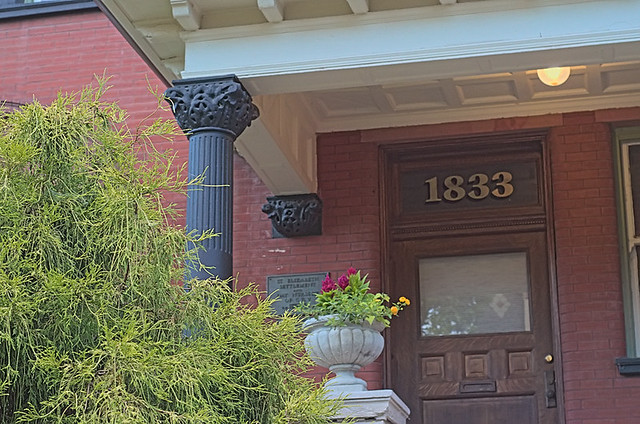
A closer view of Saint Elizabeth's.
A traditional neighborhood like this one both promotes democracy as well as private property — or, at least the traditional notions of such concepts, which are both quite specific and on a local scale. Today, both notions are far removed from their source, where decisions are made far away by strangers, and property may be taken arbitrarily by the well-connected.
While the mishmash of land uses found in Soulard would be rejected by most modern zoning laws, please consider that it was in such neighborhoods as this that many of the social problems of their day were
solved. The gracious mansions of the business owners were just around the block from the simple but noble row houses of workers. They patronized the same stores and taverns, and would see each other in the same parks. In that day, there were few large housing projects for the poor nor were there significant exurban enclaves for the wealthy.
How much better can decisions be made if ordinary people debate amongst themselves, where opposition is
man-to-man? While this system did lead to violence, at least it was between those who had a grudging respect for each other, unlike today. A Puritan-minded employer who felt the need to violently chastise an insolent subordinate was balanced by the fact that his employee lived down the block from him (and had lots of tough friends), and that there were plenty of other employers in the neighborhood to whom the employee could freely go. Likewise, an envious worker who otherwise would seek revenge, could see for himself what goes into making a successful or a failed business, for he would personally know many business owners. In this environment, the common good was more obvious to all.
Nowadays, how many factory owners live within walking distance of the their business and their employees? How many shopkeepers live above their stores? How many owners of businesses that you patronize do you personally know? How many people walk to work or walk to church? How many politicians are actually seen living in their own district? But in Soulard's heyday, these were the norm.

The tower of
Saints Peter and Paul Catholic Church. This is the parish's third church building on this site, dedicated in 1875. The
Saint Joseph Croatian church is nearby, as is
Saint John Nepomuk, as well as some Protestant churches.
Sts Peter and Paul has a small congregation, but according to its
website:
Every day from the 2nd through the 21st of each month, a free meal is served at our Parish Mid-Level Hall. These nutritious, tasty meals are served to the residents of the shelter, as well as to families and individuals in the Soulard area, who may be on limited or fixed incomes. We have between 80 and 200 guests who dine with us each day.
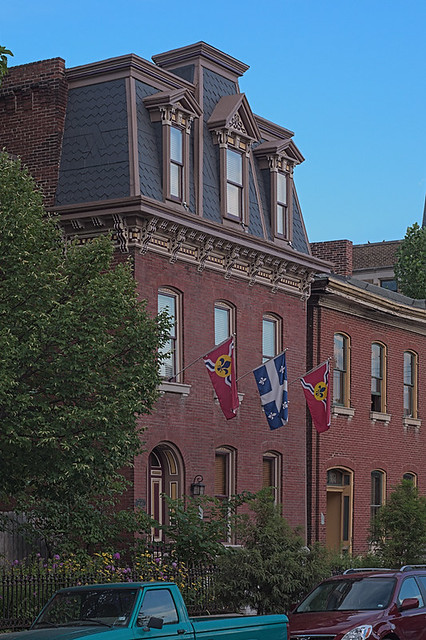
This house displays the
flag of Quebec, flanked on both sides by the
flag of the City of Saint Louis. Both flags feature the fleur-de-lys, recognizing that both were once part of the French Empire.
I remember my French grandmother enjoying visits to this neighborhood, for of all places in the City, this most reminded her of her home country.

The small yards found here are often nicely ornamented with flowers.

A decorative grille. Just because an object has a grim utilitarian purpose — in this case, keeping out intruders — that does mean that it has to lack good attractive design. This grille even has symbolic value — arrows are a sign of defense.
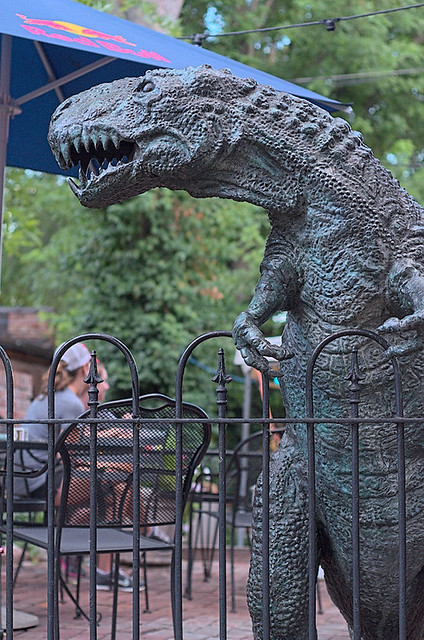
A dinosaur sculpture? I can’t explain it.
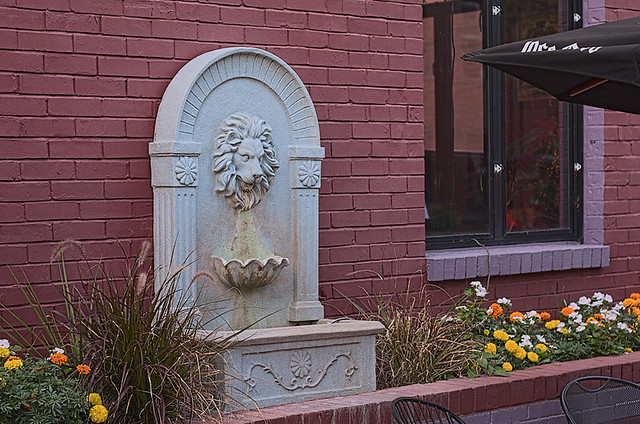
A decorative fountain with marigolds.

More flowers.

Many artists and members of the avant-garde live in this neighborhood. This is odd, since this traditional neighborhood is the antithesis of modernism, and obviously the architecture here is premodern. However, there is a deeper reason for this apparent disconnect. The philosophy of Existentialism, upon which much of modernity is built, posits and even encourages a definite opposition between the mind and the body, in a
Cartesian or even a
Gnostic-like manner; this can lead to an existential crisis, where the meaning of life is questioned. One way of coping with this kind of vertiginous crisis is through the search for
authenticity. A neighborhood such as this, which is solidly anchored in the past, can help relieve a resident of the restless pursuit of novelty, along with the negative psychological consequences of that pursuit.
Also, it would be hard to point out a contemporary neighborhood which is better designed, but well-designed neighborhoods were once the
norm, as any casual inspection of the many neighborhoods in this city will demonstrate.

The apartments and homes found here tend to be quite large by modern standards — not in land area, but certainly in square footage of livable area.
By the way, these images are made to look best at full resolution on a dark background, which can be found by clicking on each image. Reduced in size as seen here, these images look a bit rough.

This young woman asked me to take a picture with her beloved dog.

A ‘mosaic’ made of bottle caps at the
International Tap House, which is known for its variety of beers on tap. It does not serve light beers, and only sells beers from small brewers, and so it can claim
authenticity.

As I had just completed my latest book, in celebration I ordered a bottle of
Pere Jacques ale, from Chicago's Goose Island brewery. The name comes from Father Jacques Marquette, S.J., who was an early missionary in French north America, who canoed past the future site of Saint Louis in 1673.

Outdoor dining at the window.
One major difference between Soulard in its prime and Soulard today is children; few are found here. The responsibility of heading a family and raising children — denigrated and unstable vocations in our time — if absent, definitely can change the character of a neighborhood. But this area still has great charms, and lessons to teach us today.












